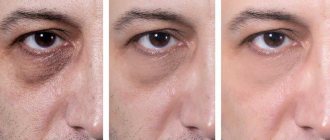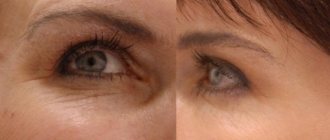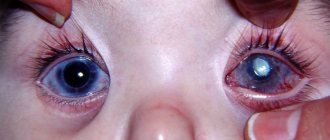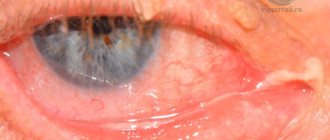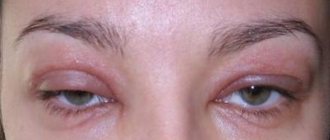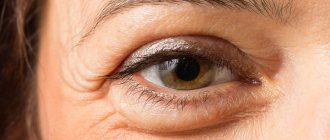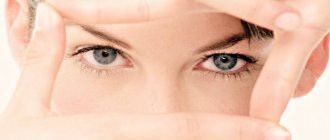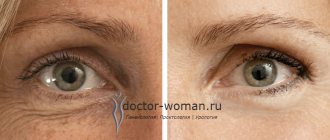Delicate and thin skin around the eyes reacts sharply to the influence of various external factors with the appearance of swelling, redness, wrinkles, and dark circles. Does the skin of the eyelids and/or the eyes themselves often turn red? The problem can be solved by using special gels, creams, homemade compresses and drops, but these remedies only bring temporary relief. If you want to forget about unpleasant symptoms forever, start by identifying the cause of their occurrence. We will talk about all the factors that cause the appearance of redness of the skin around the eyes, as well as treatment regimens for the disease in this material.
Causes
Redness of the skin around the eyes is most often caused by the following reasons:
- allergies (to cat hair, cosmetics, pollen, etc.);
- stress, lack of sleep, overwork;
- avitaminosis;
- diseases of the eyes or eyelids.
Although the most common cause of redness of the skin around the eyes is various diseases of the eyelids and eyes, the problem can also arise due to lack of sleep, lack of vitamins in the diet, or simple allergies.
Allergies to cosmetics, wool, pollen, fragrances, and medications usually manifest themselves in the form of swelling of the eyelids; both the lower and upper eyelids (together or separately) can swell. As a result of an allergic reaction, the skin itches and/or flakes, and increased lacrimation is noted.
Redness often appears as a result of vitamin deficiency, especially if the body is acutely lacking B vitamins (they are necessary for the normal functioning of all organs and systems). So those who eat haphazardly or are constantly on diets are at risk.
Causes of redness of the skin around the eyes
The skin around the eyes can turn red for various reasons:
1. Allergic reaction (may be accompanied by swelling of the eyelids, itching, increased lacrimation, and in some cases, dryness and flaking). It can occur in response to various stimuli and, accordingly, comes in different types: seasonal (to pollen of flowering plants, poplar fluff); food (for certain types of products, for example, honey, milk, eggs); medicinal (for taking certain medications or their overdose); as well as pet hair, household dust, tobacco smoke, the use of low-quality or expired cosmetics, and disinfectants in the water of public swimming pools. An examination by an allergist, in particular a scraping from the conjunctiva and skin tests with allergens, will help identify the allergen.
2. Fatigue or overstrain of the eyes may be accompanied by pain and heaviness of the eyelids (for example, when working at a computer for a long time or watching TV for a long time, from lack of sleep, from too bright or, conversely, very dim lighting in the room).
3. Dry air and stuffy rooms can cause redness of the skin around the eyes, which is usually accompanied by itching and peeling.
4. A lack of vitamin B in the body is also manifested by redness of the skin around the eyes, but it does not go away after rest and the use of various lotions, but continues to bother you for a long time. People on strict restrictive or mono-diets may suffer from a lack of vitamins.
5. Stress, as a rule, causes insomnia, and in women it also causes tears. Lack of sleep and constant rubbing of the eyes do not have the best effect on the skin around them.
6. Ophthalmological diseases, for example:
- conjunctivitis - inflammation of the mucous membrane of the eye (conjunctiva), caused by an allergic reaction or viral infection (accompanied by itching and inflammation of the skin and mucous membranes, suppuration from the eyes);
- meibomitis is an inflammation of the meibomian glands (which is often mistaken for barley), manifested by redness of the skin and mucous membranes, swelling, pain in the affected area and the presence of purulent discharge;
- barley is an acute purulent inflammation of the hair follicle of the eyelash (follicle) or the sebaceous gland at the root of the eyelashes (accompanied by itching, redness of the skin, and there may be pain when touched);
- blepharitis is a whole group of diseases that cause not only redness of the skin of the eyes, but also swelling and itching;
- demodicosis - caused by the presence of a parasitic mite living on human skin and along the hairline (eyebrows, eyelashes). Its waste products can cause rashes, peeling and redness of the skin.
7. Some diseases of internal organs can also cause redness of the skin around the eyes. In particular, these are diseases of the gastrointestinal tract, for example, dysbiosis (in this case, consultation with a gastroenterologist will be necessary) or kidneys (consultation with a nephrologist will be required).
Possible diseases
Redness of the skin of the eyelids is caused by various ophthalmological diseases. Let's look at the main ones:
- Conjunctivitis - accompanied by inflammation and discharge of pus. One of the symptoms of conjunctivitis is itching.
- Blepharitis is an infectious pathology characterized by redness of the skin of the eyelids, itching and swelling
- Meibomite is the “folk” name for barley. Appears in both children and adults.
- Demodex – itching is especially pronounced on the eyelash line; characteristic rashes are also noted on the eyelids.
Manifestations of conjunctivitis
All of the listed pathologies require specific treatment, so if the skin around the eyes is red, first rule out their presence, and only then look for allergens, vitamins, and so on.
If the disease is not treated, various unpleasant complications develop.
Treatment
The first thing you should do is rule out the presence of eye diseases. If they are, the doctor will prescribe treatment, which must be strictly adhered to. Infectious diseases are usually treated with antibiotic eye drops.
The treatment regimen for ophthalmological diseases is prescribed only by a doctor.
Suspect an allergy? Eliminate possible allergens and start taking antihistamines (tablets and/or gel). If antihistamines do not help with an allergic reaction, the doctor prescribes hormonal medications.
Read more about eye drops for allergies here.
Traditional recipes that are safe and ideal for sensitive skin help relieve redness quite well. This:
- Parsley compresses - fresh herbs are cut as finely as possible, placed in gauze bags, which are then applied to the eyes for 10 minutes.
- Lotions with chamomile decoction - make a decoction from a pharmaceutical herb, soak cotton swabs in it and apply to your eyelids.
- Baking soda – prepare a weak soda solution, soak cotton swabs or gauze in it and place them on your eyes for 15 minutes.
- Compress with dill – dill should be used in the same way as parsley.
- Tea bags are a simple and quick way that is always at hand. To achieve maximum effect, place wet tea bags in the freezer for 5-10 minutes before use.
Tea compress
Chamomile has a pronounced drying effect, so it is better not to use it if the skin is peeling.
Please note that folk recipes help relieve redness, but do not cure. If the problem comes back again, be sure to consult a doctor.
Read about the causes of red eyes in the article.
How to treat redness around the eyes
Depending on the cause of redness of the skin around the eyes, appropriate treatment is carried out.
Allergic reactions are usually treated comprehensively. First of all, isolation of the source of the allergy is required. If this is not possible (for example, with seasonal allergies), then taking antihistamines, which can be bought at the pharmacy, will help. It is better to entrust the correct selection of the appropriate product to a specialist who will take into account the data of the allergen tests you submitted. In most cases, doctors prescribe Claritin, Suprastin, Cetrin, Loratodin, etc. Gels and creams that can also be bought at the pharmacy - Gistan, Fenistil - will help deal with skin redness. For more serious manifestations of allergies, the doctor may prescribe hormonal medications. If a bacterial infection is added to the usual manifestations against the background of reduced immunity, the doctor may prescribe a course of antibiotics. If a drug allergy develops, you should tell your doctor about the drug that caused this reaction in the body and replace it with an analogue.
If diseases of the internal organs are detected, the specialist will also select the necessary medications or recommend an effective treatment method.
An ophthalmologist (ophthalmologist) will help you deal with the problems of eye diseases - he will prescribe the necessary medications and select their dosages.
Taking vitamin supplements, canceling the existing diet and switching to a diet with foods containing this vitamin (fish, liver, dairy products, grains and legumes) will help cope with the problem of vitamin deficiency.
Stuffiness and dryness in the room can be eliminated by installing an air humidifier (an aquarium can handle this role), as well as by ventilating the room. If possible, it is recommended to wipe the eyelids with ice cubes (instead of boiled water, you can freeze green tea, infusions or herbal decoctions) or apply compresses (for 5-10 minutes) from disused tea bags that have previously been cooled to room temperature.
With eye fatigue, the symptom of redness of the skin usually disappears after rest. However, if the work involves constantly watching videos and writing texts, then you should rest your eyes for 5-10 minutes every 1.5-2 hours or more often. At this time, you can walk along the office or office corridor, drink a cup of tea, or just sit with your eyes closed and try to relax as much as possible. Some people find special glasses for working at a computer helpful (they relieve eye strain).
In stressful situations, sedatives will help (for example, valerian or motherwort, mint tea before bed) and the belief that even bad things will pass sooner or later - everything will work out and everything will be fine.
Folk remedies to relieve redness of the skin around the eyes
In some cases (for example, when using low-quality cosmetics), traditional medicine can help:
- For redness and flaking of the skin, take 2 tsp. dried cornflower flowers, pour a glass of boiling water over them and leave covered for an hour. Strain the finished infusion and use it as a lotion - soak cotton pads or gauze pads in it and apply to the skin of the eyes for 5-10 minutes. Instead of cornflower flowers, you can take fresh or dried dill.
- For redness and itching, brew 1 tbsp in a glass of boiling water. chamomile and let it brew until it cools completely. Strain the finished infusion and use as a lotion or pour into ice cube trays and freeze. Use the resulting ice cubes to wipe the skin around your eyes several times a day, or at least in the morning and evening.
- For redness and inflammation of the skin, take 1 raw potato, peel and wash thoroughly, grate on a fine grater, lightly squeeze out the excess juice, add 1 tsp. vegetable (olive) oil and stir. Wrap 1 tsp in a gauze napkin. mixture and apply to eyes for 10 minutes. After the procedure, wash with cool water.
- In case of redness and irritation, chop a small bunch of fresh parsley using a meat grinder or blender. Place the resulting pulp in a gauze napkin and apply to your eyes for 10-15 minutes.
Be healthy!
Edited 01/25/2021
Prevention
To prevent the skin around your eyes from becoming red:
- Take breaks while working at the computer and try not to look at the monitor for too long.
- Monitor the air humidity - it should not be very dry. A humidifier is a real salvation during the heating season.
- Use only high-quality cosmetics for your eyes.
- Take regular walks in the fresh air.
- Get enough sleep (you need to sleep at least 8 hours a day).
- Include foods rich in B vitamins in your diet - milk, beans, fish, liver, and cereals.
Ointments for bags under the eyes
Treatment of macular degeneration of the retina, as well as symptoms and causes are presented here.
Read the specifics of using the drug Arutimol according to the official instructions at this link.
conclusions
Redness around the eyes occurs for various reasons - it could be an allergy (including an insect bite), the result of a lack of vitamins in the body or constant stress, but most often the skin turns red due to eye diseases. Therefore, be sure to consult a doctor so that he can conduct a thorough diagnosis and make an accurate diagnosis. Treatment depends on the cause of the pathology; folk recipes help to quickly relieve redness. In addition, we advise you to familiarize yourself with the removal of hernias under the eyes.
Also read about allergy drops for children.
Symptoms
Symptoms and the degree of their severity depend on the cause of the eye disease. Most often, patients complain of swollen eyes, as this manifestation accompanies many pathologies.
Let's consider the negative external manifestations in the eye area in connection with the most common diseases. Very often a person is exposed to infectious influences, which, in addition to the red color of the eyelids and mucous membranes, are accompanied by the following additional symptoms:
- pain manifestations;
- itching sensation;
- profuse lacrimation;
- blurred vision;
- red dots under the eyes;
- dry skin near the eyes.
With conjunctivitis, inflammation is accompanied by clinical manifestations, the set of which depends on the type of disease:
- itching, pain and lacrimation (allergic form);
- bright red conjunctiva and photophobia (viral disease);
- swelling and redness, grayish or yellowish discharge, the eye hurts and burns, the patient complains that something is bothering the eye (bacterial form).
In some cases, infections can cause peeling of the dermis. The same sign may indicate that a skin mite has “settled” under the epithelium.
Important! Infectious diseases are treated with antibiotics, but only a doctor can determine the right medicine.
If the skin under the eye swells, the eyelid is swollen and red, take a closer look to see if there is a purulent formation (red sac) on the affected area. A purulent grain that hurts when pressed - barley, dense, hot swelling - phlegmon. Additional symptoms of the latter are red spots and severe pain.
The manifestation of these symptoms depends on the individual characteristics of the body; you can quickly get rid of them under the supervision of a specialist. The doctor will determine the cause of the pathology and prescribe the correct treatment.


